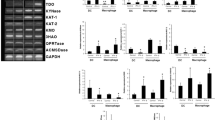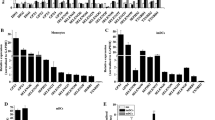Abstract
Zinc ions (Zn2+) are food components with favourable effects in infectious disease. Zn2+ is taken up into dendritic cells (DCs), key players in the regulation of innate and adaptive immunity. In other cell types, Zn2+ has been shown to stimulate the formation of ceramide, which is in turn known to trigger suicidal cell death. The present study explored whether Zn2+ modifies ceramide formation and survival of bone marrow derived DCs. To this end, DCs were isolated from acid sphingomyelinase knockout (asm −/−) and corresponding wild type (asm +/+) mice and treated with different concentrations of Zn2+. Ceramide formation was assessed with anti-ceramide antibodies in FACS and immunohistochemical analysis, sub-G1 cell population by FACS analysis, break down of phosphatidylserine asymmetry by annexin V binding, cell death by propidium iodide incorporation, metabolic cell activity by MTT assay, ROS production from dichlorofluorescein fluorescence and activation of MAPKs by Western blotting. The treatment of asm +/+ DCs with low Zn2+ concentrations (up to 100 μM) was followed by ceramide formation, increase in sub-G1 cell population and phosphatidylserine exposure, effects blunted in asm −/− DCs. The treatment of DCs with C2-ceramide increased the percentage of sub-G1 and apoptotic DCs from both genotypes. Zn2+ led to similar activation of MAPKs in asm +/+ and asm −/− DCs and did not affect ROS production. Higher concentrations of Zn2+ led to a marked increase of propidium iodide incorporation in DCs of both genotypes. The present study reveals that in DCs Zn2+ triggers ceramide formation, which in turn compromises cell survival.






Similar content being viewed by others
References
Murakami M, Hirano T (2008) Intracellular zinc homeostasis and zinc signaling. Cancer Sci 99:1515–1522
Prasad AS (1995) Zinc: an overview. Nutrition 11:93–99
Cuevas LE, Koyanagi A (2005) Zinc and infection: a review. Ann Trop Paediatr 25:149–160
Fischer-Walker C, Black RE (2004) Zinc and the risk for infectious disease. Annu Rev Nutr 24:255–275
Richard SA, Zavaleta N, Caulfield LE et al (2006) Zinc and iron supplementation and malaria, diarrhea, and respiratory infections in children in the Peruvian Amazon. Am J Trop Med Hyg 75:126–132
Hambidge KM (2006) Zinc and pneumonia. Am J Clin Nutr 83:991–992
Brown KH, Lopez dR, Arsenault JE et al (2007) Comparison of the effects of zinc delivered in a fortified food or a liquid supplement on the growth, morbidity, and plasma zinc concentrations of young Peruvian children. Am J Clin Nutr 85:538–547
Litonjua AA, Rifas-Shiman SL, Ly NP et al (2006) Maternal antioxidant intake in pregnancy and wheezing illnesses in children at 2 y of age. Am J Clin Nutr 84:903–911
Prasad AS, Beck FW, Bao B et al (2007) Zinc supplementation decreases incidence of infections in the elderly: effect of zinc on generation of cytokines and oxidative stress. Am J Clin Nutr 85:837–844
Berger MM, Shenkin A (2007) Trace element requirements in critically ill burned patients. J Trace Elem Med Biol 21(Suppl 1):44–48
Fraker PJ, King LE (2004) Reprogramming of the immune system during zinc deficiency. Annu Rev Nutr 24:277–298
Prasad AS (1998) Zinc and immunity. Mol Cell Biochem 188:63–69
Hosea HJ, Rector ES, Taylor CG (2003) Zinc-deficient rats have fewer recent thymic emigrant (CD90+) T lymphocytes in spleen and blood. J Nutr 133:4239–4242
Ibs KH, Rink L (2003) Zinc-altered immune function. J Nutr 133:1452S–1456S
Prasad AS (2000) Effects of zinc deficiency on Th1 and Th2 cytokine shifts. J Infect Dis 182(Suppl 1):S62–S68
Adler HS, Steinbrink K (2007) Tolerogenic dendritic cells in health and disease: friend and foe!. Eur J Dermatol 17:476–491
Banchereau J, Briere F, Caux C et al (2000) Immunobiology of dendritic cells. Annu Rev Immunol 18:767–811
van Duivenvoorde LM, Han WG, Bakker AM et al (2007) Immunomodulatory dendritic cells inhibit Th1 responses and arthritis via different mechanisms. J Immunol 179:1506–1515
Steinbrink K, Mahnke K, Grabbe S et al (2009) Myeloid dendritic cell: from sentinel of immunity to key player of peripheral tolerance? Hum Immunol 70:289–293
Cerovic V, McDonald V, Nassar MA et al (2009) New insights into the roles of dendritic cells in intestinal immunity and tolerance. Int Rev Cell Mol Biol 272:33–105
Edelman SM, Kasper DL (2008) Symbiotic commensal bacteria direct maturation of the host immune system. Curr Opin Gastroenterol 24:720–724
Rescigno M, Lopatin U, Chieppa M (2008) Interactions among dendritic cells, macrophages, and epithelial cells in the gut: implications for immune tolerance. Curr Opin Immunol 20:669–675
Kitamura H, Morikawa H, Kamon H et al (2006) Toll-like receptor-mediated regulation of zinc homeostasis influences dendritic cell function. Nat Immunol 7:971–977
Tabas I (1999) Secretory sphingomyelinase. Chem Phys Lipids 102:123–130
Carpinteiro A, Dumitru C, Schenck M et al (2008) Ceramide-induced cell death in malignant cells. Cancer Lett 264:1–10
Grassme H, Becker KA, Zhang Y et al (2008) Ceramide in bacterial infections and cystic fibrosis. Biol Chem 389:1371–1379
Jana A, Hogan EL, Pahan K (2009) Ceramide and neurodegeneration: susceptibility of neurons and oligodendrocytes to cell damage and death. J Neurol Sci 278:5–15
Lang F, Gulbins E, Lerche H et al (2008) Eryptosis, a window to systemic disease. Cell Physiol Biochem 22:373–380
Perrotta C, De Palma C, Clementi E (2008) Nitric oxide and sphingolipids: mechanisms of interaction and role in cellular pathophysiology. Biol Chem 389:1391–1397
Smith EL, Schuchman EH (2008) The unexpected role of acid sphingomyelinase in cell death and the pathophysiology of common diseases. FASEB J 22:3419–3431
Horinouchi K, Erlich S, Perl DP et al (1995) Acid sphingomyelinase deficient mice: a model of types A and B Niemann-Pick disease. Nat Genet 10:288–293
Lin T, Genestier L, Pinkoski MJ et al (2000) Role of acidic sphingomyelinase in Fas/CD95-mediated cell death. J Biol Chem 275:8657–8663
Inaba K, Inaba M, Romani N et al (1992) Generation of large numbers of dendritic cells from mouse bone marrow cultures supplemented with granulocyte/macrophage colony-stimulating factor. J Exp Med 176:1693–1702
Shumilina E, Zahir N, Xuan NT et al (2007) Phosphoinositide 3-kinase dependent regulation of Kv channels in dendritic cells. Cell Physiol Biochem 20:801–808
Wang K, Mahmud H, Foller M et al (2008) Lipopeptides in the triggering of erythrocyte cell membrane scrambling. Cell Physiol Biochem 22:381–386
Berridge MV, Tan AS (1993) Characterization of the cellular reduction of 3-(4,5-dimethylthiazol-2-yl)-2,5-diphenyltetrazolium bromide (MTT): subcellular localization, substrate dependence, and involvement of mitochondrial electron transport in MTT reduction. Arch Biochem Biophys 303:474–482
Orlov SN, Thorin-Trescases N, Pchejetski D et al (2004) Na+/K+ pump and endothelial cell survival: [Na+]i/[K+]i-independent necrosis triggered by ouabain, and protection against apoptosis mediated by elevation of [Na+]i. Pflugers Arch 448:335–345
Rudolf E, Cervinka M (2008) External zinc stimulates proliferation of tumor Hep-2 cells by active modulation of key signaling pathways. J Trace Elem Med Biol 22:149–161
Franklin RB, Costello LC (2009) The important role of the apoptotic effects of zinc in the development of cancers. J Cell Biochem 106:750–757
Haase H, Rink L (2009) Functional significance of zinc-related signaling pathways in immune cells. Annu Rev Nutr 29:133–152
Vallee BL, Gibson JG (1948) The zinc content of normal human whole blood, plasma, leucocytes, and erythrocytes. J Biol Chem 176:445–457
Massadeh A, Gharibeh A, Omari K et al (2010) Simultaneous determination of Cd, Pb, Cu, Zn, and Se in human blood of Jordanian smokers by ICP-OES. Biol Trace Elem Res 133:1–11
Blindauer CA, Harvey I, Bunyan KE et al (2009) Structure, properties, and engineering of the major zinc binding site on human albumin. J Biol Chem 284:23116–23124
Outten CE, O’Halloran TV (2001) Femtomolar sensitivity of metalloregulatory proteins controlling zinc homeostasis. Science 292:2488–2492
Falcone S, Perrotta C, De Palma C et al (2004) Activation of acid sphingomyelinase and its inhibition by the nitric oxide/cyclic guanosine 3′,5′-monophosphate pathway: key events in Escherichia coli-elicited apoptosis of dendritic cells. J Immunol 173:4452–4463
Handley ME, Thakker M, Pollara G et al (2005) JNK activation limits dendritic cell maturation in response to reactive oxygen species by the induction of apoptosis. Free Radic Biol Med 38:1637–1652
Lundqvist A, Nagata T, Kiessling R et al (2002) Mature dendritic cells are protected from Fas/CD95-mediated apoptosis by upregulation of Bcl-X(L). Cancer Immunol Immunother 51:139–144
Leverkus M, Walczak H, McLellan A et al (2000) Maturation of dendritic cells leads to up-regulation of cellular FLICE-inhibitory protein and concomitant down-regulation of death ligand-mediated apoptosis. Blood 96:2628–2631
Willems F, Amraoui Z, Vanderheyde N et al (2000) Expression of c-FLIP(L) and resistance to CD95-mediated apoptosis of monocyte-derived dendritic cells: inhibition by bisindolylmaleimide. Blood 95:3478–3482
Nicolo C, Tomassini B, Rippo MR et al (2001) UVB-induced apoptosis of human dendritic cells: contribution by caspase-dependent and caspase-independent pathways. Blood 97:1803–1808
von Bulow V, Rink L, Haase H (2005) Zinc-mediated inhibition of cyclic nucleotide phosphodiesterase activity and expression suppresses TNF-alpha and IL-1 beta production in monocytes by elevation of guanosine 3′,5′-cyclic monophosphate. J Immunol 175:4697–4705
Telford WG, Fraker PJ (1995) Preferential induction of apoptosis in mouse CD4+CD8+alpha beta TCRloCD3 epsilon lo thymocytes by zinc. J Cell Physiol 164:259–270
Kolenko VM, Uzzo RG, Dulin N et al (2001) Mechanism of apoptosis induced by zinc deficiency in peripheral blood T lymphocytes. Apoptosis 6:419–429
Mann JJ, Fraker PJ (2005) Zinc pyrithione induces apoptosis and increases expression of Bim. Apoptosis 10:369–379
Weiss JH, Sensi SL (2000) Ca2+-Zn2+ permeable AMPA or kainate receptors: possible key factors in selective neurodegeneration. Trends Neurosci 23:365–371
Weiss JH, Sensi SL, Koh JY (2000) Zn(2+): a novel ionic mediator of neural injury in brain disease. Trends Pharmacol Sci 21:395–401
Ostrakhovitch EA, Cherian MG (2005) Role of p53 and reactive oxygen species in apoptotic response to copper and zinc in epithelial breast cancer cells. Apoptosis 10:111–121
Klein C, Creach K, Irintcheva V et al (2006) Zinc induces ERK-dependent cell death through a specific Ras isoform. Apoptosis 11:1933–1944
Acknowledgments
The authors gratefully acknowledge the meticulous preparation of the manuscript by Lejla Subasic and Tanja Loch. This work was supported by the Deutsche Forschungsgemeinschaft (SFB 766).
Conflict of interest statement
The authors declare that they have no conflict of interest.
Author information
Authors and Affiliations
Corresponding author
Rights and permissions
About this article
Cite this article
Shumilina, E., Xuan, N.T., Schmid, E. et al. Zinc induced apoptotic death of mouse dendritic cells. Apoptosis 15, 1177–1186 (2010). https://doi.org/10.1007/s10495-010-0520-x
Published:
Issue Date:
DOI: https://doi.org/10.1007/s10495-010-0520-x




